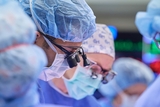What are pilonidal cysts and sinuses?
Pilonidal cysts and sinuses are a spectrum of pilonidal disease conditions that occur between the buttocks (gluteal crease or cleft) near the tailbone in the lower back. Pilonidal cysts can range from abscesses — painful collections of pus — to sinuses, and lead to persistent bloody drainage.
Typically, pilonidal cysts occur after puberty and are more common among young men and teen boys than their female counterparts.
Causes of pilonidal cysts
The shape of the area between the buttocks and beneath the small of the back lends itself to the development of pilonidal disease. With the combination of body hair, hormones, hygiene, and other unknown factors that occur after puberty, pilonidal cysts can form, and pilonidal disease can occur.
Although hair within the gluteal crease is likely a major factor causing pilonidal cysts and sinuses, no single cause can be used to explain the full spectrum of disease.
When there is ongoing irritation under the skin in this area, a pilonidal tract (small opening in the skin) can form, allowing additional hair, oil and debris to travel under the skin. This collection of hair, oil and debris can get trapped under the skin, become infected and form an abscess or abnormal bump on the skin’s surface.
Pilonidal cyst symptoms
Commonly, the first sign of a pilonidal cyst is an abscess. Thick, course body hair around the cyst increases the chance of the sinus becoming infected.
Symptoms of pilonidal cysts may include:
- Pain, swelling or redness
- A lump at the tailbone
- Pus or blood drainage
- Warmth at the site
In some cases, these symptoms may be mistaken for being the result of an injury or prolonged sitting such as after travel.
Diagnosing pilonidal cysts
Most pilonidal cysts are identified through a careful physical exam by an experienced physician. A visual examination of the buttocks and gluteal crease may reveal pits or tiny holes in the skin, abscesses or sinuses.
In some cases, your child’s physician may request imaging – such as a pelvic MRI – to help determine the severity of the cysts, risk for infection, and to help guide treatment or support surgical planning.
Pilonidal cyst treatment
The treatment for pilonidal cysts and sinuses varies from child to child, depending on the symptoms, and may include antibiotics, incision and drainage, and/or surgery.
- Antibiotics: If your child presents with an infected cyst or abscess, antibiotics may be necessary to treat the infection. The antibiotics may be taken orally (by mouth) or injected by IV, depending on the severity of the condition.
- Incision and drainage: Some youth with pilonidal cysts or sinuses will require drainage of the affected area. This procedure can take place in the doctor’s office or may require an outpatient procedure visit.
- Surgery: If your child has multiple pilonidal cysts, is experiencing pain or has significant discomfort, surgery may be the most effective way to treat pilonidal disease and prevent further infections.
Pilonidal cyst surgery
The main purpose of pilonidal cyst surgery is to remove the festering hair from under the skin and reduce its chance of regrowth. The four most common surgeries used to treat pilonidal cysts and promote healing in the gluteal crease are:
- Cleaning the pits: When symptoms are minimal and the accumulation is local to the pits, the pus-filled craters under the skin may be able to be cleansed without an incision using instruments, brushes or small endoscopes.
- Minimal pilonidal sinus excision, with or without endoscopy: When a dominant tract for the pilonidal cyst(s) exists, and there is significant local accumulation in the pit(s), the tract may be removed with an incision no larger than the track itself. Surgery can sometimes be enhanced using a small (3mm) endoscope to assist in the extraction (removal) of hair and debris.
- Radical excision, with or without closure: When there are multiple affected sinuses in an area, a radical excision of all sinuses and causal pits maybe performed and the wound left open or closed simply.
- Radical excision, with rotation or off-center flap: When there are multiple pilonidal cysts and affected sinuses in an area, a radical excision of all sinuses and causal pits may be performed. The wound is then closed using a variety of methods to move the wound/scar to allow better healing. The most common technique used today is called the gluteal cleft lift.
After-surgery care for pilonidal disease
Both cleaning the pits and minimal pilonidal sinus excision have virtually no restrictions post-procedure and minimal recovery time. Radical excision procedures involve a larger portion of the gluteal cleft, require a longer recovery time, and may leave a significant scar.
After surgery, it is important to keep the surgical site and nearby areas clean and free of hair. This will improve healing.
Here’s what you can do at home:
- Practice good hygiene. Keeping the area clean and free of hair will improve healing. Deep cleansing in the gluteal cleft and compulsive drying of the area is important. No topical creams are needed.
- Hair removal. When patients are hairy, hair removal is a very important component of preventing recurrence and supporting healing. Your child’s physician can discuss different techniques, and which may be best in your child’s scenario. These may include:
- Trimming with an electric clipper (Note: Shaving with a razor of any kind is NOT recommended in this area as it may cause irritation and increase the risk of infection.
- Using a depilatory cream or lotion to remove unwanted hair from a specific area.
- Laser hair removal of the affected area.
When to call the doctor after pilonidal cyst removal
If your child is exhibiting any signs of infection – including redness, swelling, drainage from the incision site, fever or pain that is not managed with oral pain medications – or if you have any questions or concerns, please contact CHOP’s Division of Pediatric General, Thoracic and Fetal Surgery at 215-590-2730.

Why choose CHOP for your child's surgery
If your child needs surgery, you want to know their care is in the hands of the best, most compassionate team. CHOP's world-class pediatric surgeons and experienced staff are here for you.

Preparing for surgery
Find tips to prepare for your preoperative visit with CHOP’s pediatric general surgeons, and resources to help prepare your child for surgery.
Resources to help
Division of Pediatric General, Thoracic and Fetal Surgery Resources
We have created resources to help you find answers to your questions and feel confident with the care you are providing your child.
